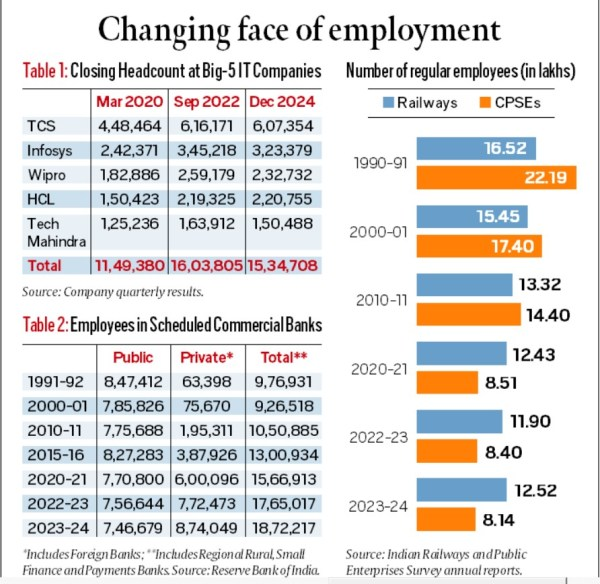Syllabus: GS3/Economy
Context
- The trend of organised employment has been shifting from the public to private sector — especially post the economic reforms of 1991.
About
- India’s middle class after Independence was largely created by the public sector.
- Employment in the public sector stood at 194.7 lakh and that in the organised private sector only at 80.6 lakh in 1995.
- The employees in the central and state governments plus quasi-governments (public sector undertakings) and local bodies — fell to 176.1 lakh and the latter rose to 119.7 lakh by 2012.
Major Trends
- Regular employees with the Indian Railways: Between 1990-91 and 2022-23, these plunged from 16.5 lakh to 11.9 lakh.
- Employees in the IT Sector: Tata Consultancy Services (TCS) and Infosys already had 45,714 and 36,750 employees respectively at the end of 2004-05, which rose to 4,48,464 and 2,42,371 fifteen years later.
- Banking sector transformation: In 1991-92, of the total employee strength of the scheduled commercial banks in India the Public sector banks had a share of 87%.
- At the end of 2023-24, the private employee strength was 8.74 lakh, as against the less than 7.5 lakh of public sector banks.

Reasons for the Transformation of Working Middle Class in India:
- Economic Liberalization: Post-1991 reforms opened up the economy, leading to the growth of the private sector and more job opportunities.
- Higher Salaries and Benefits: The private sector often offers better pay, career growth, and benefits compared to public sector jobs, attracting the middle class.
- Improved Work Culture: It provides a more dynamic and performance-driven environment, which appeals to the ambitious working middle class.
- Limited Public Sector Jobs: The growth of public sector jobs has stagnated, and competition for these positions is high, making private sector jobs more attractive.
- Entrepreneurial Opportunities: The rise in entrepreneurial ventures and startups has encouraged the middle class to shift towards private businesses and self-employment.
Challenges faced by India
- Employment in the Agriculture Sector: India has not experienced structural transformation of surplus labour from agriculture to other sectors.
- As per the Periodic Labour Force Surveys (PLFS) farm sector’s share in India’s workforce decreased from 64% in 1993-94 to 42.5% in 2018-19, but is subsequently going up to 46.2% in 2023-24.
- Most services sector jobs are informal and low-paying:
- India with almost 85% informal labour is generating more than half of the country’s GDP.
- A high proportion of socially and economically underprivileged sections of society are concentrated in informal economic activities.
Reasons for Increase in the Share of Informal Sector in India’s Employment:
- Unskilled Labour: The education system emphasises theoretical knowledge over practical proficiency. This approach renders new graduates ill-prepared to meet industry demands.
- Rural-Urban Divide: Inaccessible areas are hardly getting quality programmes for their training and industry exposure.
- Technological Changes: The rise of gig economy platforms and casual labor opportunities has expanded the informal sector.
- Flexibility: Many workers prefer the flexibility of informal work, even though it lacks benefits like healthcare and pensions.
Challenges Related to Informal Sector in India
- Low Wages and Exploitation: Informal employment, by definition, lacks a written contract, paid leave, and hence does not pay minimum wages or pay attention to working conditions.
- Lack of Social Security: Workers in the informal sector often lack access to social security benefits such as healthcare, pensions, and unemployment insurance.
- Limited Access to Finance: Informal sector workers and businesses often struggle to access formal financial services such as bank loans and credit.
- Poor Quality of Life: Unorganized sector workers were far more likely to be poor than their organised sector counterparts.
Way Forward
- Bridging the Gap in Education: Aligning Education with Industry Demand Changes will prepare students for real-world challenges.
- Government Initiatives: The programmes can focus on areas like installation of solar energy, waste management, and precision agriculture.
- Public-private partnerships in the green sector can ensure that such training is relevant and impactful.
- Strengthening Rural Skilling Initiatives: Leveraging technology to scale online platforms can ensure equitable access to quality education.
- Incentivising for Retention of Employees: Offering tailored upskilling programmes, encouraging inclusive work cultures, and having mental health support can enhance employee satisfaction and retention.
Source: IE
Previous article
Urban Environmental Protests: Chipko Legacy in Cities
Next article
News In Short-17-02-2025